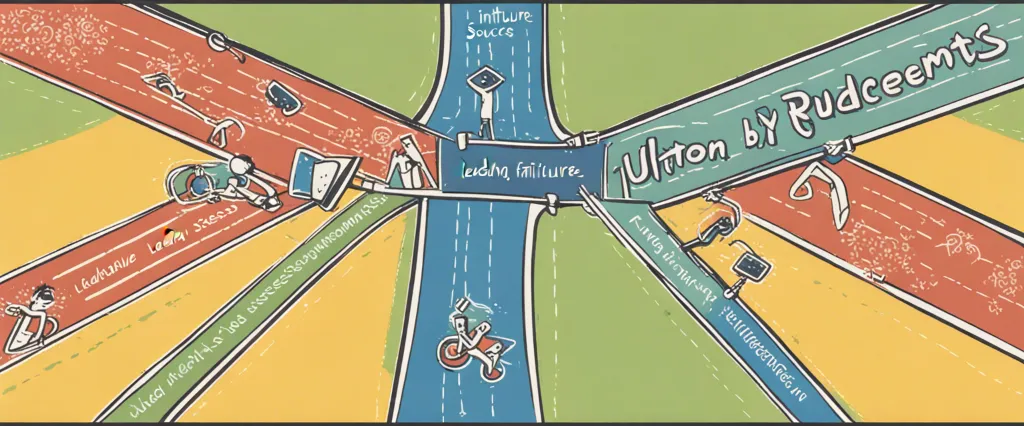In “Fooled by Randomness,” acclaimed author Nassim Nicholas Taleb takes readers on a captivating journey into the world of probability and illusion. Drawing upon his deep understanding of mathematics, statistics, and human behavior, Taleb embarks on an exploration of how randomness influences our lives. As a renowned scholar, economist, and former trader, Taleb’s unique perspective allows him to shed light on the hidden flaws and biases in our understanding of success and failure. With his sharp wit and incisive analysis, Taleb challenges conventional wisdom and invites readers to reexamine their beliefs about luck, skill, and the often elusive nature of certainty.
Chapter 1: The Illusion of Certainty: Unraveling the Veil of Randomness
In Chapter 1 of “Fooled by Randomness,” author Nassim Nicholas Taleb explores the illusion of certainty and the pervasive influence of randomness in our lives. Taleb challenges the human tendency to attribute meaning and causality to events that are actually random or purely a result of chance.
Taleb begins by discussing his own experiences as a successful trader. He highlights the common belief among traders that they have the ability to predict and control the market, when in reality, their successes are often random outcomes. He argues that people tend to perceive patterns and narratives to rationalize the outcomes, creating an illusion of certainty and expertise.
The author introduces the concept of “silent evidence,” explaining how we typically only hear about the successes of others, blinding us to the countless failures that go unnoticed. This skewed view leads to an overestimation of people’s abilities and reinforces the illusion of certainty.
Taleb criticizes the overuse of historical data and the retrospective fallacy, where people assume that past events were predictable when they were not. He warns against relying too heavily on historical data to make future predictions, emphasizing that randomness and unpredictable events play a significant role in outcomes.
Ultimately, Taleb highlights the importance of understanding the impact of randomness in decision-making and learning to embrace uncertainty. He advocates for a more humble and skeptical approach towards our own abilities and the narratives we construct to explain the world around us. By unraveling the veil of randomness, Taleb encourages readers to question their assumptions and acknowledge the limits of our knowledge.
Chapter 2: The Role of Luck: Understanding the Influence of Chance in Life
Chapter 2 of “Fooled by Randomness” by Nassim Nicholas Taleb delves into the role of luck and chance in our lives. Taleb argues that humans have a natural tendency to underestimate the influence of randomness on their achievements and instead attribute success solely to their skills or abilities.
Taleb begins by introducing the concept of survivorship bias, which refers to the tendency to focus only on the successful outcomes while ignoring the failed ones. He explains that this bias can lead individuals to falsely believe that their success is solely a result of their skills, rather than acknowledging the element of luck involved.
The author then explores the misconception of “winners” and “losers” in various fields of life, such as investing or sports. He highlights the fact that there is often a thin line separating these two categories and that luck plays a significant role in determining the outcomes. Taleb argues that those who achieve success should be cautious in attributing it solely to their own abilities, as they might have been favored by fortune.
Additionally, Taleb introduces the concept of alternative histories, emphasizing that small and seemingly insignificant events can have a profound impact on the course of our lives. He warns against the temptation to construct deterministic narratives that ignore the role of chance.
In conclusion, Chapter 2 of “Fooled by Randomness” emphasizes the crucial role of luck and chance in our lives. It urges readers to adopt a more humble perspective when evaluating their successes and to be aware of the influence of randomness on outcomes. By doing so, individuals can gain a better understanding of the world and avoid the trap of attributing everything solely to their own abilities.
Chapter 3: Cognitive Biases and Misjudgments: How Our Minds Deceive Us
Chapter 3 of “Fooled by Randomness” explores the concept of cognitive biases and misjudgments that affect our decision-making processes, leading us to be deceived by randomness. Nassim Nicholas Taleb highlights various psychological phenomena that cause us to make incorrect assumptions and flawed judgments.
Taleb begins by introducing the concept of confirmation bias, where individuals tend to seek and interpret information that confirms their existing beliefs. This bias leads us to discount or ignore evidence that contradicts our preconceived notions, making us susceptible to misinformation and false conclusions.
He then discusses the phenomenon of narrative fallacy, which refers to our tendency to create narratives or stories to explain random or unconnected events. This inclination to find meaning in everything can lead us to attribute causality where none exists, leaving us deceived by randomness.
Taleb also explores the impact of hindsight bias, where we tend to believe, after an event has occurred, that we could have predicted it beforehand. This bias distorts our perception of the accuracy of our predictions, making us overestimate our abilities and underappreciate the role of luck or randomness in the outcome.
Additionally, the chapter delves into the concept of representativeness bias, where individuals focus on characteristics or similarities that fit a particular category or stereotype and ignore important information that may suggest otherwise. This bias can lead to faulty generalizations and misjudgments.
Through the examination of these cognitive biases and misjudgments, Taleb emphasizes the importance of recognizing our inherent limitations in understanding the role of randomness in our lives. By acknowledging these biases, we can become more vigilant in our decision-making processes and avoid being fooled by the unpredictable and often deceptive nature of randomness.
Chapter 4: The Fallacy of Hindsight: Learning from Past Mistakes

Chapter 4 of “Fooled by Randomness” by Nassim Nicholas Taleb, titled “The Fallacy of Hindsight: Learning from Past Mistakes,” delves into the human tendency to misjudge events and outcomes, particularly when looking back on past mistakes.
Taleb opens the chapter by highlighting the powerful role of hindsight bias in shaping our perception of the world. Hindsight bias refers to our inclination to believe that we can easily explain past events and predict future outcomes based on our understanding of the past. However, this belief is flawed, as it oversimplifies the complexity and randomness inherent in life.
The author points out that we often attribute too much causality to past events that turned out to be significant or harmful, while ignoring the countless other events that did not have such outcomes. This fallacy arises from our desire to create narratives and find patterns in hindsight, falsely assuming that these patterns were predictable. Taleb argues that many historical events are simply the result of randomness and chance, but we find meaning in them after the fact.
Taleb introduces the concept of the “narrative fallacy” to further illustrate this point. The narrative fallacy arises when we construct stories that connect seemingly related events, even though there may be no objective connection between them. These narratives help us make sense of the world, but they often mislead us and prevent us from understanding the inherent randomness and unpredictability of reality.
In conclusion, Taleb emphasizes that we should be cautious when trying to learn from past mistakes. Instead of relying on hindsight and constructing narratives that may misrepresent reality, we need to accept the inherent randomness of life and make decisions based on a probabilistic understanding of uncertainty. By embracing uncertainty, we can better navigate the unpredictable nature of the world and avoid falling victim to the fallacy of hindsight.
Chapter 5: Randomness in Financial Markets: Navigating the Uncertainty of Investments
Chapter 5 of “Fooled by Randomness” by Nassim Nicholas Taleb, titled “Randomness in Financial Markets: Navigating the Uncertainty of Investments,” explores the role of randomness and uncertainty in the world of finance and investments.
Taleb warns against the common misconception that financial markets are purely deterministic and constantly driven by rational factors. He highlights the importance of recognizing the role that randomness plays in these markets. Although financial professionals and investors may employ complex models and analysis, it is crucial to acknowledge that randomness and unpredictability are integral components of the system.
The chapter delves into the concept of “naive empiricism” or assuming that events are more predictable than they actually are. Taleb emphasizes that our inability to fully comprehend randomness can lead to inaccurate predictions and poor investment decisions. He argues that financial markets are influenced by unpredictable events and chance occurrences, often referred to as “black swans.” These events have extreme impacts and are only evident in hindsight. However, many investment strategies ignore the possibility of such black swans, which can result in significant losses.
Taleb suggests that accepting uncertainty and incorporating it into investment strategies is essential. He advocates for a risk management approach that focuses on protecting capital against rare, catastrophic events rather than solely chasing high returns. By diversifying investments and using risk mitigation techniques, such as hedging, investors can better navigate the uncertainty of financial markets.
In summary, Chapter 5 of “Fooled by Randomness” emphasizes the pervasive role of randomness in financial markets and the need for investors to acknowledge and plan for uncertainty. By recognizing the limitations of models and predictions, and by implementing risk management strategies, investors can better navigate the volatile and unpredictable nature of financial markets.
Chapter 6: The Narrative Fallacy: Untangling the Stories We Tell Ourselves
In Chapter 6 of “Fooled by Randomness” by Nassim Nicholas Taleb, titled “The Narrative Fallacy: Untangling the Stories We Tell Ourselves,” the author explores the concept of how humans are prone to constructing narratives to make sense of random events and attributing patterns where none actually exist.
Taleb begins by pointing out that our minds naturally seek causal explanations for events, constantly craving a coherent story. We tend to reshape reality to fit a preconceived narrative, leading to the creation of narratives that offer a sense of meaning and order.
He argues that this narrative fallacy becomes particularly dangerous when it comes to our perception of success. People often attribute their own achievements to personal brilliance, skills, or hard work, while conveniently dismissing the role of luck and random factors. This skewed perception can lead to an overestimation of our own abilities and an underestimation of the role of chance.
To illustrate his point, Taleb provides examples from different domains, including finance, entrepreneurship, and historical events. He demonstrates how random outcomes are often retroactively transformed into stories in order to make them more comprehensible and justified.
The author emphasizes that acknowledging the presence of randomness and the limitations of our narratives is crucial for a more accurate understanding of the world. By recognizing the impact of chance and embracing uncertainty, we can become more humble and open to learning from both successes and failures.
In summary, Chapter 6 of “Fooled by Randomness” warns against the narrative fallacy, highlighting how humans tend to construct stories to make sense of random events. It emphasizes the importance of recognizing the influence of luck and randomness in order to gain a more accurate understanding of the world and avoid the pitfalls of overconfidence.
Chapter 7: Risk and Probability: Embracing Uncertainty in Decision Making
Chapter 7 of “Fooled by Randomness” by Nassim Nicholas Taleb explores the concepts of risk and probability and how individuals often struggle to properly account for uncertainty in their decision-making processes.
Taleb begins by highlighting the limitations of human intuition when it comes to understanding and evaluating risk. He argues that our minds are wired to see patterns and seek certainty, making it difficult for us to grasp the true randomness of events. This tendency to overlook uncertainty leads people to make inaccurate predictions and underestimate the probability of unlikely occurrences.
The author then introduces the concept of the “survivorship bias,” which occurs when only successful outcomes are taken into account, ignoring the failures. This bias is particularly prevalent in the financial industry, where successful investors are often hailed as geniuses, while the failures are forgotten. Taleb emphasizes the importance of considering these failures to gain a more realistic understanding of risk.
Taleb emphasizes the need to rely on a more robust framework for decision making — one that explicitly acknowledges uncertainty and incorporates the concept of probability. He explains that individuals should aim to avoid situations with a large potential downside, even if the probability of occurrence is relatively low. This approach, known as the “barbell strategy,” involves investing the majority of resources in safe, low-risk options while keeping a small portion reserved for high-risk, high-reward opportunities.
In conclusion, Chapter 7 of “Fooled by Randomness” delves into the inadequacy of human intuition in dealing with risk and probability. Taleb argues for the necessity of incorporating uncertainty into decision-making processes and highlights the importance of considering failures and outliers to gain a more accurate understanding of unpredictable events.

Chapter 8: Antifragility: Thriving in a Random World
Chapter 8 of “Fooled by Randomness” delves into the concept of antifragility and how individuals can thrive in an unpredictable world. Nassim Nicholas Taleb argues that being merely robust or resilient is not enough; instead, one should aim to become antifragile.
Antifragility refers to a system’s ability to benefit from shocks and uncertainty. Taleb explains that while fragility is susceptible to harm from stressors, robustness can withstand such stressors without gaining any advantages. On the other hand, antifragile systems improve and grow stronger in the face of volatility.
To illustrate this idea, the author applies it to different domains. He discusses corporations that benefit from financial crises by acquiring distressed assets at bargain prices. Taleb presents antifragile individuals who engage in ventures with limited downside risks but significant potential upside gains. By embracing uncertainty, these individuals expose themselves to positive Black Swan events that can lead to outsized success.
Taleb emphasizes the importance of experimenting with low-risk, high-reward actions. He encourages individuals to take asymmetric bets, where the potential upside is much larger than the potential downside. Through trial and error, one can learn and adapt, leveraging the power of randomness to their advantage.
Furthermore, the author highlights that society often suffers from over-optimization and excessive control, leading to vulnerability and the stifling of antifragility. He argues for the importance of decentralized decision-making and local solutions, as they allow for adaptation and the emergence of new insights.
In this chapter, Taleb challenges the traditional notions of stability and encourages readers to adopt an antifragile mindset. By accepting and even seeking randomness, individuals can thrive in an unpredictable world, benefiting not just from successes but also from failures and unexpected events.
After Reading
In conclusion, “Fooled by Randomness” by Nassim Nicholas Taleb sheds light on the often overlooked role of luck and randomness in our lives, particularly in the context of financial markets and decision-making. Taleb’s exploration delves into the dangers of relying solely on historical data and the illusion of control, as he emphasizes the impact of unpredictable events on our outcomes. By challenging common assumptions and providing practical insights, the book advocates for a more humble and probabilistic approach to understanding success and failure. “Fooled by Randomness” serves as a thought-provoking reminder to question our assumptions and consider the elements of chance that shape our experiences, ultimately encouraging a deeper appreciation for uncertainty in a world driven by luck.
1. The Black Swan: The Impact of the Highly Improbable” by Nassim Nicholas Taleb – If you enjoyed “Fooled by Randomness,” this is another must-read from the same author. In this book, Taleb explores the concept of unpredictable, outlier events that have a significant impact on our lives and how we often fail to account for them in our decision-making.
2. Thinking, Fast and Slow” by Daniel Kahneman – This masterpiece by Nobel laureate Daniel Kahneman delves into the psychology of decision-making. It explores the two systems of thinking that drive our choices: the fast, intuitive system, and the slower, more deliberate system. It uncovers the biases and heuristics that often lead us to make irrational decisions.
3. “Antifragile: Things That Gain from Disorder” by Nassim Nicholas Taleb – Taleb takes another deep dive into probability in this insightful book. He explores the idea of being antifragile, which means thriving and benefiting from shocks, volatility, and randomness. Taleb challenges conventional wisdom and offers strategies for becoming more resilient and adaptable to the unpredictability of life.
4. “Thinking in Bets: Making Smarter Decisions When You Don’t Have All the Facts” by Annie Duke – Former professional poker player Annie Duke provides a unique perspective on decision-making through the lens of poker. In this book, Duke shares her strategies for making better decisions in uncertain situations, emphasizing the importance of embracing uncertainty and approaching decisions as bets rather than certainties.
5. “The Drunkard’s Walk: How Randomness Rules Our Lives” by Leonard Mlodinow – Mlodinow explores the role of randomness in our lives by examining its impact on various fields such as economics, physics, and biology. He reveals the hidden patterns in seemingly random events and teaches us how to make sense of probabilities. Engaging and enlightening, this book challenges our perception of cause and effect.




